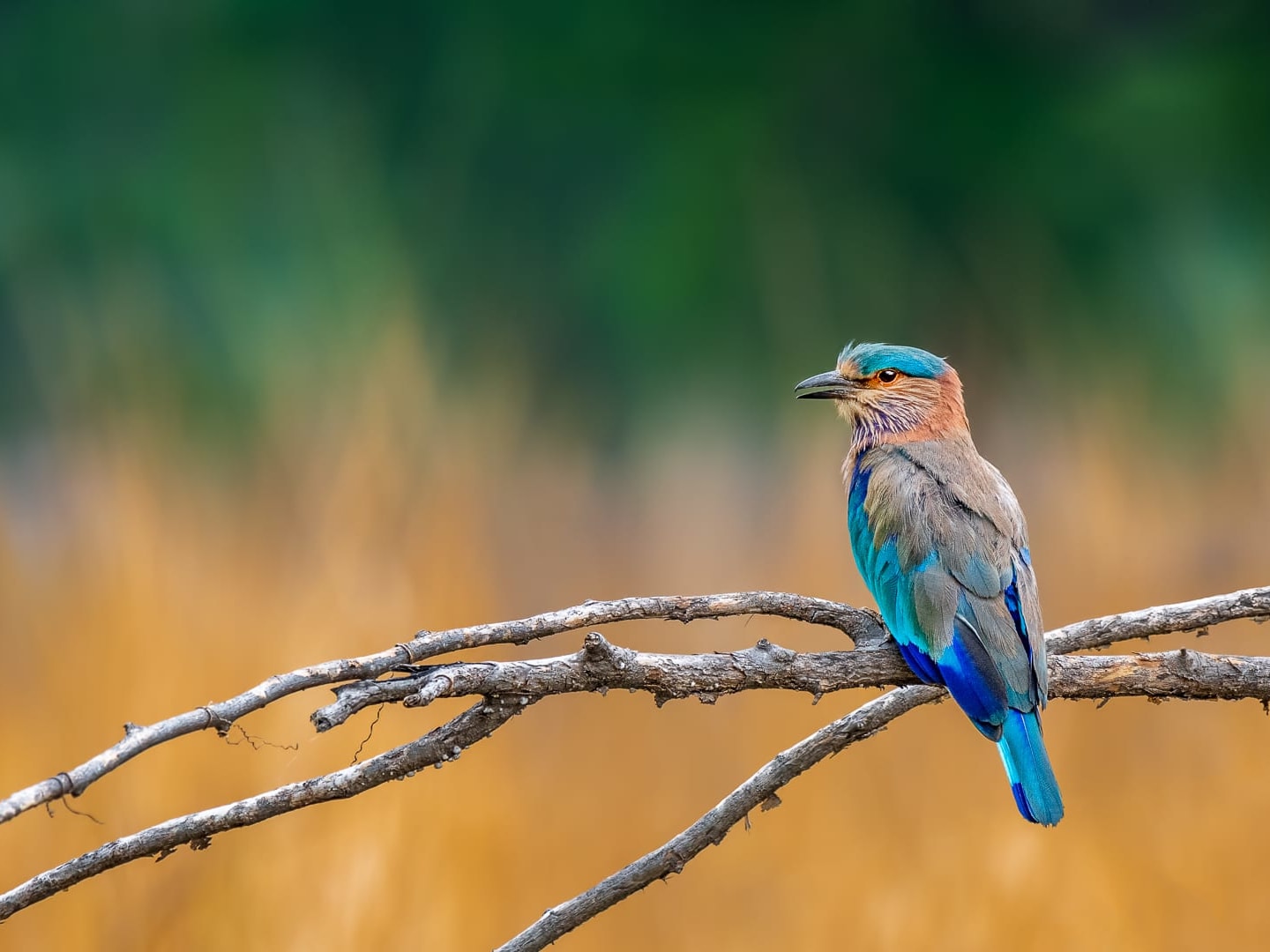 Listen to this article
•
15:34 min
Listen to this article
•
15:34 min
You can usually meet the rock ‘n’ rollers while driving in the countryside. They will be perched sedately on powerlines, fenceposts, earth clods, the tops of bare trees or termite mounds — anywhere they can command a clear view of their surroundings. They are usually found singly or in pairs. Indian rollers (Coracias benghalensis) are crow-sized (30-34 cm) birds with big heads and beaks and sporting a wolfish grin.
Their heads are turquoise, throat and neck streaky cinnamon, wings are dark to light shades of blue, and the tail is turquoise, tipped with navy. When they fly, they take your breath away as their wings dazzle with contrasting blues, and tail feathers banded with turquoise and dark blue fan out. Unlike kingfishers, which they invariably remind you of, they fly slowly and deliberately on broad wings, so you can appreciate their colours properly. Both ladies and gentlemen are identically clad.
Cover photo: The Indian roller sits on exposed perches in open farmlands and forested areas, pastures, plantations, palm groves, dry acacia and Prosopis woods, riverbanks, and wires along roads. Photo: Abhishek Das
The Indian roller is a bird of open grasslands and scrub forests, resident all over India, and doesn’t mind staying in human-modified habitats: gardens, orchards, and fields. From its perch, it keeps watch for insects (beetles are a favourite consisting 45 per cent of its insect intake, followed by grasshoppers at 25 per cent), small reptiles, amphibians, mammals, and even birds. On spotting a potential meal, it will casually parachute down from its perch on curved wings, snap it up, either deal with it on the spot or fly back to the perch and bash the daylights out of its victim before swallowing it. Termites are a delicacy, and though these birds are usually loners, as many as 40 have been seen dining together on a termite swarm beneath a 70-metre stretch of powerlines. They have also been known to snap up insects disturbed by herds of livestock and the great Indian bustard as it moves through the grasslands. They will follow tractors on their route through fields for the same reason. Indian rollers have even been spotted diving for fish — something that could cause a good deal of confusion for a newbie birder whose first reaction, not unexpectedly, would be to think it’s a kingfisher! And indeed, the roller does dive rather like the kingfisher, even if it doesn’t fly like one.
The best time to check them out is in the breeding season, which stretches from March to June in most parts of the country, though it is a little earlier in South India. Sometimes, both birds of a pair put on a spectacular display, though it usually is just the gentleman. He will rocket straight up from his perch, execute a series of rollercoaster waves, up and down, twisting from side to side, somersaulting, looping the loop, all the while uttering loud, raucous love cries — a true rock ‘n’ roll performance in every way, including the vocal talent. Carried away by his own exuberance (and maybe love), he may even playfully dive straight at his beloved on her perch. Eventually, he will sit by her side, and both will ceremoniously bow and duck at each other and indulge in a bit of canoodling — riffling each other’s plumage with their beaks in what is called allopreening.
Naturally, family responsibilities follow, and a home is made in a tree hole or earth bank, lightly lined with grass and straw. The female lays between 3 and 5 eggs, and both parents bring up their young, which fledge within around a month. The babies are fiercely protected by their extremely territorial parents. Uttering raucous “kak-kak-kak!” war cries, they will fly at intruders such as jungle crows (and even humans). On at least one occasion, they have been recorded taking on an Egyptian vulture (Neophron peronepterus).
While Indian rollers are in no immediate danger of extinction (“Least concern” on the IUCN’s Red List), and their numbers are believed to be increasing, they are threatened by habitat loss and death by electrocution. At the time when fancy feathers became fashionable, they were shot in large numbers for their plumage. A nomadic fortune-telling tribe in the Vishakapatnam area also considered them fortune-tellers and wore their plumage. In West Bengal, they were considered a good omen and caught and released during Dusshera and Durga Puja. They are the state birds of Andhra Pradesh, Odisha, Karnataka, and Telangana.
The European Roller (Coracias garrulus) arrives in India from Central Asia as a passage migrant to winter in Africa. It is, if anything, a paler, washed-out version of the Indian roller, finished in powder blue and cinnamon, with black and pale blue wings. The bird breeds in western Europe, southern and east-central Europe, Central Asia (and Kashmir) as well as North Africa.
Worldwide there are nine species of rollers, their range stretching from Indonesia to southern Europe, though most species are found on the African continent. They are distantly related to bee-eaters and orioles. And yes, they get their name, “rollers”, from their exuberant topsy-turvy, loop-the-loop flight displays during the breeding season. Modern humans might want to emulate the roller by doing something similar on a date rather than arranging yet another dinner at an overpriced lounge bar.











